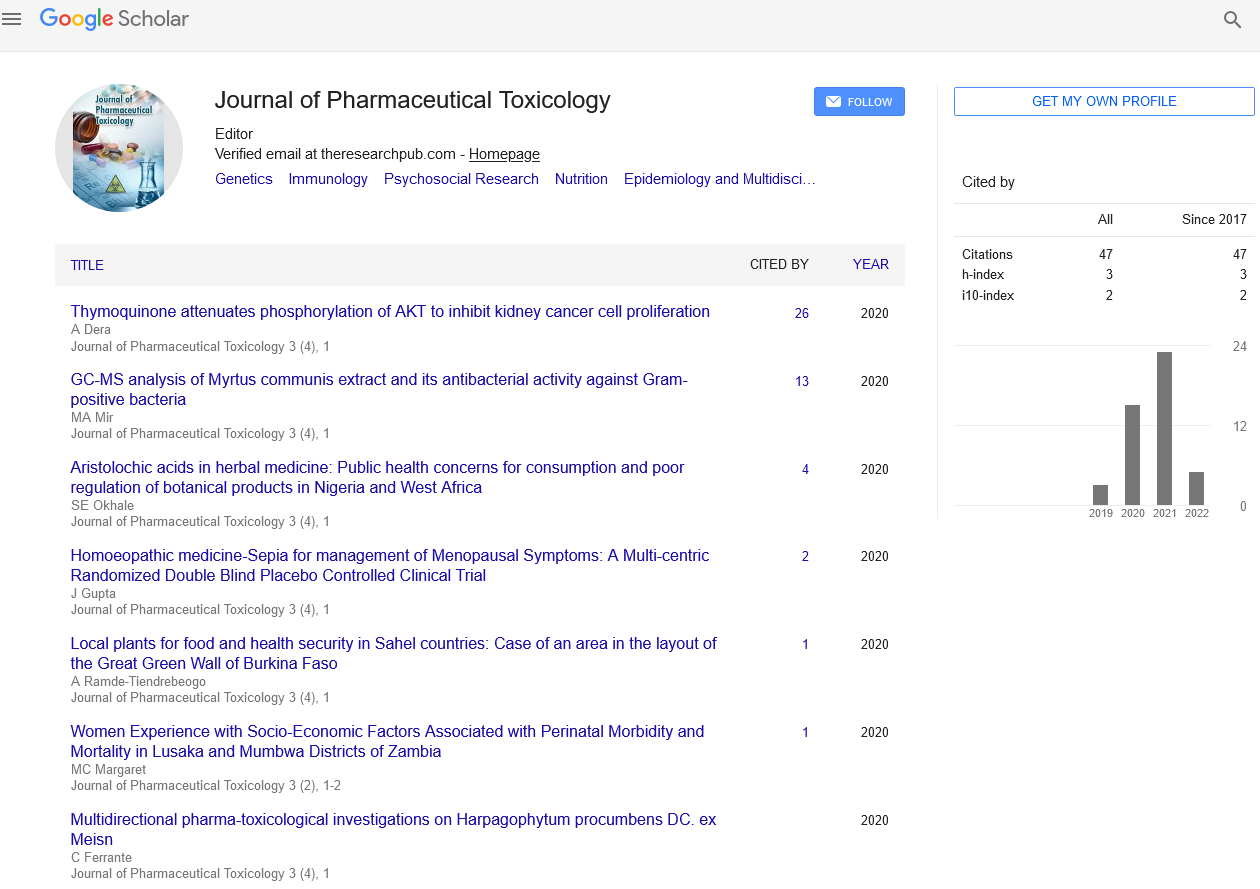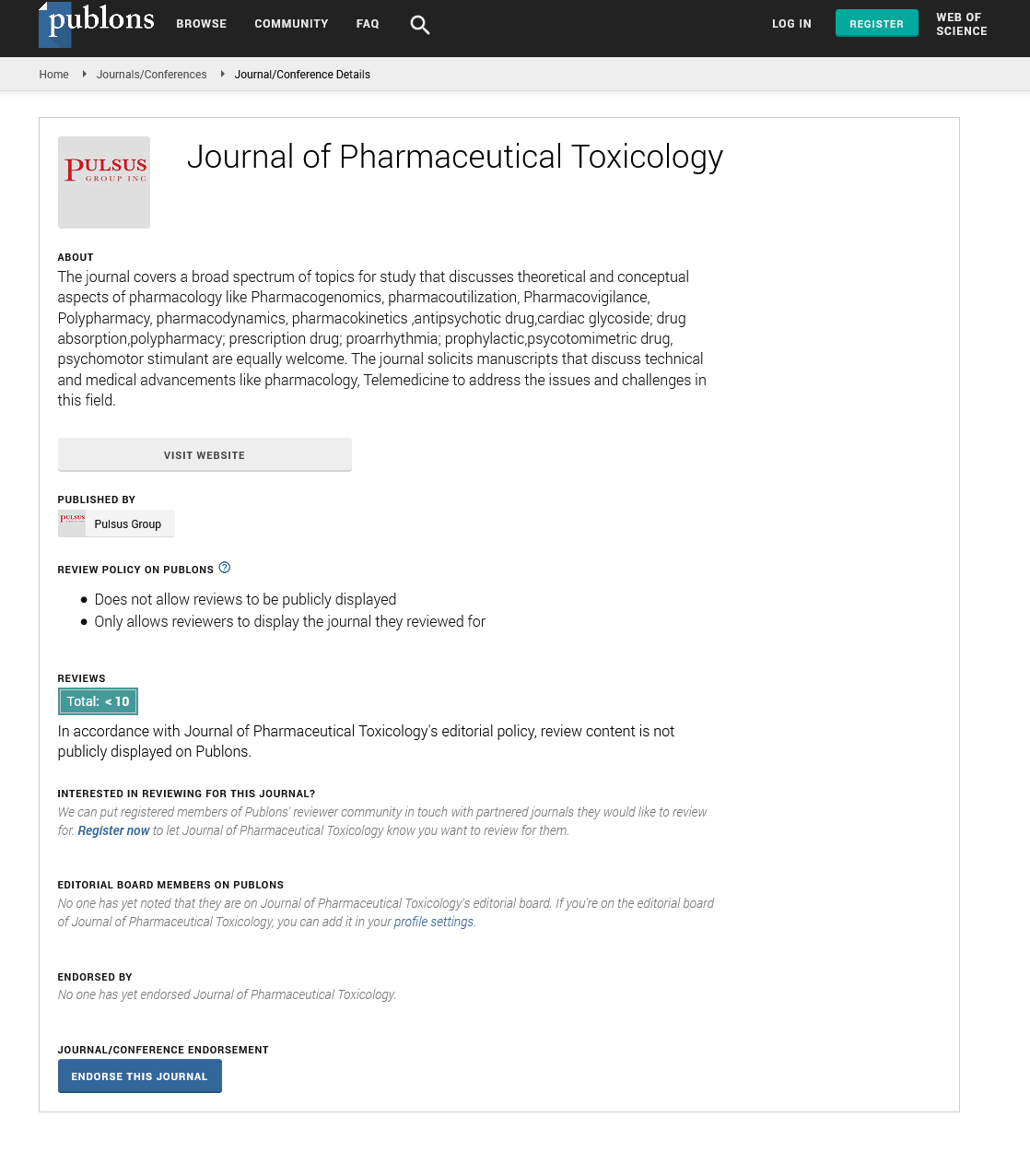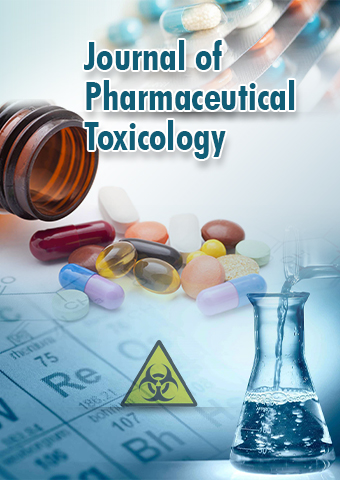Review Article - Journal of Pharmaceutical Toxicology (2023) Volume 6, Issue 1
Evaluation of Pharmacological Safety and Genetic Toxicology
Mohammad Abdollahi*
Toxicology and Diseases Group (TDG), Pharmaceutical Sciences Research Center (PSRC), Tehran University of Medical Sciences, Tehran, Iran
Toxicology and Diseases Group (TDG), Pharmaceutical Sciences Research Center (PSRC), Tehran University of Medical Sciences, Tehran, Iran
E-mail: mohammad@abdollahi.edu.ir
Received: 01-Feb-2023, Manuscript No. jpt-23-89069; Editor assigned: 04-Feb-2023, PreQC No. jpt-23- 89069(PQ); Reviewed: 18-Feb-2023, QC No. jpt-23-89069; Revised: 25- Feb-2023, Manuscript No. jpt-23- 89069(R); Published: 28-Feb-2023, DOI: 10.37532/jpt.2023.6(1).17-20
Abstract
Forsythin, the main ingredient in Forsythia suspensa, is widely used clinically to treat fever, gonorrhoea, ulcers, and viral colds. Forsythin’s potential genetic toxicity and human safety were the goals of this study. The Ames test, chromosome aberration (CA) test, and bone marrow micronucleus (MN) test in vivo were used to evaluate the genetic toxicity of forsythin in accordance with Good Laboratory Practice regulations and test guidelines. Five Salmonella typhimurium strains were subjected to various concentrations of forsythin in the presence or absence of the S9 mixture in the Ames test, and the number of His + revertant colonies were then counted. Chromosome aberrations were observed in Chinese hamster lung (CHL) fibroblast cells treated with various concentrations of forsythin, mitomycin C, or cyclophosphamide in the presence or absence of the S9 mixture during the CA test. In the MN test, the ratios of polychromatic erythrocytes (PCE) and erythrocytes (PCE/(PCE + NCE)) were measured in bone marrow taken from mice that had undergone various treatments. Beagle dogs were then divided into four groups—a negative control, a low dose, a medium dose, and a high dose—and a telemetry system was used to test whether or not forsythin was safe to use. According to the Ames test results, the presence or absence of the S9 mixture did not significantly increase the number of colonies in any of the test strains or treatments. In the CA test, the number of aberrant cells in CHL fibroblast cells treated with low, medium, and high doses of forsythin for 24 to 48 hours in the absence of the S9 mixture was 5.0/2.5, 4.5/1.5, and 5.0/5.0, while the number was 5.0, 5.0, and 4.5 in the presence of the S9 mixture. These results demonstrated that there was no significant difference between the positive and negative control groups when the S9 mixture was present (2.0) or not (4.0/2.5 for 24 or 48 hours). The MN test revealed that forsythin had no cytotoxicity because the PCE/ (PCE + NCE) values in the negative, positive, and treatment groups were all greater than 20%. Additionally, the telemetry technique revealed no significant toxicological effects of forsythin on the conscious beagle dogs of various groups’ electrocardiograms, temperature, respiration, or other physiological indicators. Forsythin’s low likelihood of genetic toxicity and absence of significant toxicological effects supported our hypothesis that it is suitable for further research and application.
Keywords
pharmacological research • drug safety • safety pharmacology • clinical • Translation • toxicology • biological • pathology
Introduction
Traditional Chinese medicine (TCM) has been used in medicine for a long time in China. TCM has been getting more and more attention all over the world due to its unique therapeutic effects and ability to treat health issues that Western medicines cannot address. Approximately 80% of the world’s population, or 4 billion people, are using TCM for medical treatment, according to reports. People have been led to believe that natural treatments are safer than pharmaceutical ones due to historical knowledge of herbs. Due to its widespread use, TCM’s efficacy and safety must be further investigated [1].
Thumb’s Forsythia suspensa Vahl, The family Oleaceae, which is a member of the genus Forsythia, is found in China, Korea, Japan, and some European nations. Clinically, Forsythia suspensa, a TCM herb, is widely used to treat fever, gonorrhoea, ulcers, and viral colds. Forsythin, Forsythia suspensa’s main ingredient, is an important metric for determining its quality. Forsythia suspensa’s leaves contained more effective components, such as forsythin, forsythiaside, and oleanolic acid, than its fruits did, according to previous research. Forsythin extracted from the leaves of Forsythia suspensa will significantly increase the medicinal and economic value of this medicinal material resource, according to Pharmacoeconomic [2].
According to Yang et al., forsythin also has a number of pharmacological properties, such as antibacterial, antioxidative, antiviral, hypolipidemic, hepatoprotective, antiinflammatory, antioxidative stress, and antiapoptotic properties. Demonstrated that by regulating the expression of inflammatory cytokines (IL-6, IL-1, and NF-kB), forsythin was able to reduce the zebra fish’s neutrophil infiltration and tissue necrosis caused by lipopolysaccharide (LPS), Another study found that forsythin and autophagy blockers could induce apoptosis and inhibit the proliferation of human laryngeal carcinoma epithelial cells (HEp-2 cells), suggesting a novel approach to treating laryngeal squamous cell carcinoma. Forsythin’s safety, on the other hand, is still poorly understood [3].
By detecting base substitution or frame shift mutations in a target gene, the Ames test evaluates a substance’s mutation. One of the most common cell lines used to study chromosome abnormalities is Chinese hamster lung (CHL) fibroblasts. The genetic material that is left outside of the cell nucleus during mitosis anaphase because of spindle fragmentation or intracellular chromosomal disruption is called the micronucleus. In addition, using a telemetry system on conscious animals is recommended because it can reduce the impact of anesthesia and animal activity restriction and increase the test’s sensitivity to safety pharmacology parameters. Based on the China Food and Drug Administration (CFDA) and Organization for Economic Cooperation and Development (OECD) Good Laboratory Practice (GLP) regulations and test guidelines, the Ames test, chromosomal aberrations (CA) test, bone marrow micronucleus (MN) test, and telemetry method were used in this study to investigate the genetic toxicity of forsythin as well as its safe use [4].
Discussion
Natural products have received a growing amount of attention recently due to their numerous sources, pharmacological functions, low prices, and minimal side effects. The majority of studies have examined the species of natural products and their active ingredients. In Asia, Forsythia suspensa is used as a single herb and in compound prescriptions. It has been reported to have heat-clearing and detoxifying properties. Forsythin, a typical component of Forsythia suspensa, has numerous biological effects, including neuroprotective, anti-inflammatory, antibacterial, antioxidant, and viral effects. Ma and co. showed that COVID-19 and HCoV- 229E’s in vitro proliferation could be inhibited by forsythin, and that it could be used to control the coronavirus disease in 2019. Additionally, the fruit of Forsythia suspensa has been evaluated for their safety. Yin and co. analyzed the mutagenic potential of 102 raw drugs and discovered that the Ames test was negative for the extraction of Forsythia suspensa fruits, whereas the CA and MN tests were both positive [5]. The Ames test (5000 g/plate), the MN test (5000 mg/kg), and the CA test (1100–2500 g/mL) all revealed that the aqueous extract of Forsythia viridissima fruits did not exhibit any Genotoxicity. Forsythin’s genetic toxicology and safety pharmacology was the subject of our first study. Forsythin did not have any genetic toxicity, as the Ames, CA, and MN in vivo tests all returned negative results. Additionally, there were no significant differences in MP, heart rate, QTcF, body temperature, respiratory rate, or tidal volume among conscious beagle dogs treated with different doses of forsythin, indicating that forsythin was safe and had no toxicity. Based on these findings, forsythin may be suitable for further research and application [6].
Genetic toxicology is an important link for drug candidates to move from the discovery stage to the clinical stage and the market, and it is an important part of the nonclinical safety evaluation of drugs. Forsythin’s potential Genotoxicity was investigated in our study using the Ames, CA, and MN tests. After forsythin, the number of His + revertant colonies in all test strains did not significantly differ from that of the negative and positive controls, regardless of whether the S9 mixture was present or not. These proved that forsythin does not cause mutations in the tested strains. The genetic information is carried by chromosomes, which are made up of DNA and proteins and have distinctive morphologies and structures. External mutagens are likely to harm them, possibly resulting in morphological and structural distortions [7].
Our study’s CA test revealed that the incidence of chromosomal aberrations did not significantly differ between the negative control and forsythin treatment groups, indicating that forsythin could not cause chromosomal aberrations in cells. Altering the number of polychromatic erythrocytes with micronucleus in rodent bone marrow can also be used to determine the genotoxic effects of test substances based on chromosome breakage and/or damage. The maximum tolerated dose in this experiment was 18,000 mg/kg, or 923 times the human clinical dosage. MN test results showed that all forsythin treatment groups had MNPCE rates below 2%, and there was no significant difference between the negative control and forsythin treatment groups in PCE/ (PCE + NCE). It is possible to deduce from the Ames test, CA test, and MN test results that forsythin may not be Genotoxic [8].
Forsythin’s safety pharmacology evaluation was also the subject of additional research. There are three main systems in the pharmacologic evaluation of preclinical safety: cardiovascular system, respiratory system, and nervous system large animals like dogs and monkeys are typically used in cardiovascular system research. The telemetry system not only makes it easier to thoroughly analyse the pharmacological effects of drugs, but it also follows the principle of animal experiments, which helps speed up the process of developing new drugs. Monitoring the cardiovascular and respiratory systems of conscious animals, Johnson and other used telemetry to investigate the pharmacology of resveratrol’s cardiovascular safety and discovered that it had no effect [9].
After being treated with forsythin, our research revealed that MP and QTcF were either shorter or longer, and that heart rate was either higher or lower. However, the dogs in the negative control group also experienced similar phenomena, but the duration of their occurrence was brief and there were no manners that were dose-or time-dependent.
There was no significant difference in the body temperature index between the groups because the daytime temperature change was within 1 °C and the average percentage of change was less than 3%, both of which indicate that there was no significant difference. The effects of forsythin were not responsible for the variations in respiratory rate and tidal volume because of animals’ normal physiological rhythm changes. When taken as a whole, it can be deduced that these changes may not be related to the forsythin treatment but rather to changes in the animals’ sitting posture and physiological rhythm [10].
Conclusion
Forsythin’s Ames test, CA assay, and in vivo MN assay all came back negative, indicating that its use in clinical settings may not pose a significant risk of genetic toxicity. Additionally, conscious beagle dogs did not exhibit any significant toxicological effects of forsythin on their cardiovascular or respiratory systems. Our findings demonstrate the biosafety of forsythin and contribute significantly to a better understanding of its biosafety for future applications.
Conflict of Interest
None
Acknowledgement
None
References
- Jia Q, Wang L, Zhang X et al. Prevention and treatment of chronic heart failure through traditional Chinese medicine: role of the gut microbiota. Pharmacol Res Commun. 151:104-110, (2019).
- Guo H, Liu AH, Li L et al. Simultaneous determination of 12 major constituents in Forsythia suspensa by high performance liquid chromatography-DAD method. J Pharm Biomed Anal. 43:1000-1006 (2007).
- Santos Radai JA, Silva Graciani F, Berno CR et al. Genetic toxicological assessment and anti-arthritic effects of an ethanolic extract obtained from Salvia lachnostachys Benth leaves in mice. Regul Toxicol Pharmacol. 92:239-244 (2018).
- Ward G, Milliken P, Patel B et al. Comparison of non-invasive and implanted telemetric measurement of blood pressure and electrocardiogram in conscious beagle dogs. J Pharmacol Toxicol Methods. 66:106-113 (2012).
- Bitzer J, Henkel T, Nikiforov AI et al. Genetic toxicity studies of glycolipids from Dacryopinax spathularia. Food Chem Toxicol. 123:162-168 (2019).
- Yun JW, You JR, Kim YS et al. In vitro and in vivo safety studies of cinnamon extract (Cinnamomum cassia) on general and genetic toxicology. Regul Toxicol Pharmacol. 95:115-123 (2018).
- Dong Z, Lu X, Tong X et al. Forsythiae Fructus: a review on its photochemistry, quality control, pharmacology and pharmacokinetics. Molecules. 22:14-66(2017).
- Oualili H, Nmila R, Chibi F et al. Chemical composition and antioxidant activity of Origanum elongatum essential oil. Pharmacogn Res. 11:283 (2019).
- Umudi EQ. Nutritive values of the leaves of Crescentia cujete (Ugbuba). Int J Chem. 11:106-109 (2019).
- Adesina S, Johnny I, Olayiwola G et al. Plants in respiratory disorders II- Antitussives. Br J Pharm Res. 16:1-21 (2017).
Google Scholar, Crossref, Indexed at
Google Scholar, Crossref, Indexed at
Google Scholar, Crossref, Indexed at
Google Scholar, Crossref, Indexed at
Google Scholar, Crossref, Indexed at
Google Scholar, Crossref, Indexed at
Google Scholar, Crossref, Indexed at
Google Scholar, Crossref, Indexed at
Google Scholar, Crossref, Indexed at


